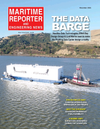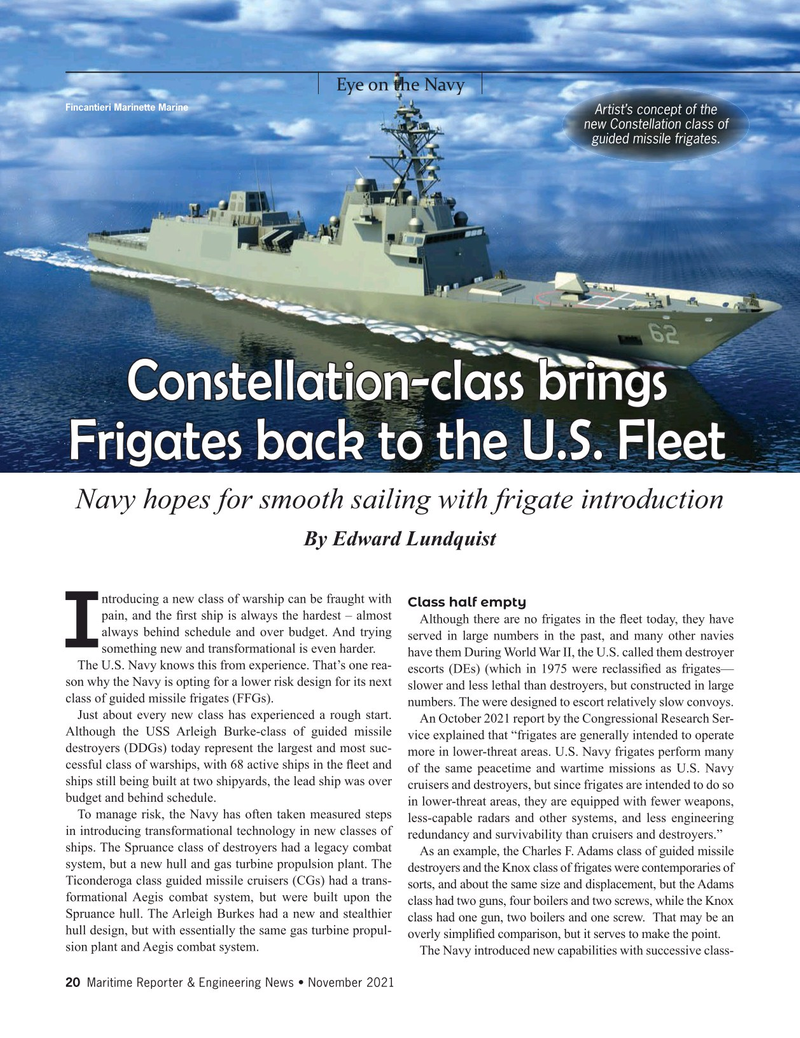
Page 20: of Maritime Reporter Magazine (November 2021)
The Workboat Edition
Read this page in Pdf, Flash or Html5 edition of November 2021 Maritime Reporter Magazine
Eye on the Navy
Fincantieri Marinette Marine
Artist’s concept of the new Constellation class of guided missile frigates.
Constellation-class brings
Frigates back to the U.S. Fleet
Navy hopes for smooth sailing with frigate introduction
By Edward Lundquist ntroducing a new class of warship can be fraught with Class half empty pain, and the ? rst ship is always the hardest – almost
Although there are no frigates in the ? eet today, they have always behind schedule and over budget. And trying served in large numbers in the past, and many other navies
I something new and transformational is even harder.
have them During World War II, the U.S. called them destroyer
The U.S. Navy knows this from experience. That’s one rea- escorts (DEs) (which in 1975 were reclassi? ed as frigates— son why the Navy is opting for a lower risk design for its next slower and less lethal than destroyers, but constructed in large class of guided missile frigates (FFGs).
numbers. The were designed to escort relatively slow convoys.
Just about every new class has experienced a rough start.
An October 2021 report by the Congressional Research Ser-
Although the USS Arleigh Burke-class of guided missile vice explained that “frigates are generally intended to operate destroyers (DDGs) today represent the largest and most suc- more in lower-threat areas. U.S. Navy frigates perform many cessful class of warships, with 68 active ships in the ? eet and of the same peacetime and wartime missions as U.S. Navy ships still being built at two shipyards, the lead ship was over cruisers and destroyers, but since frigates are intended to do so budget and behind schedule.
in lower-threat areas, they are equipped with fewer weapons,
To manage risk, the Navy has often taken measured steps less-capable radars and other systems, and less engineering in introducing transformational technology in new classes of redundancy and survivability than cruisers and destroyers.” ships. The Spruance class of destroyers had a legacy combat
As an example, the Charles F. Adams class of guided missile system, but a new hull and gas turbine propulsion plant. The destroyers and the Knox class of frigates were contemporaries of
Ticonderoga class guided missile cruisers (CGs) had a trans- sorts, and about the same size and displacement, but the Adams formational Aegis combat system, but were built upon the class had two guns, four boilers and two screws, while the Knox
Spruance hull. The Arleigh Burkes had a new and stealthier class had one gun, two boilers and one screw. That may be an hull design, but with essentially the same gas turbine propul- overly simpli? ed comparison, but it serves to make the point.
sion plant and Aegis combat system.
The Navy introduced new capabilities with successive class- 20 Maritime Reporter & Engineering News • November 2021
MR #11 (18-33).indd 20 11/4/2021 9:40:46 AM

 19
19

 21
21
